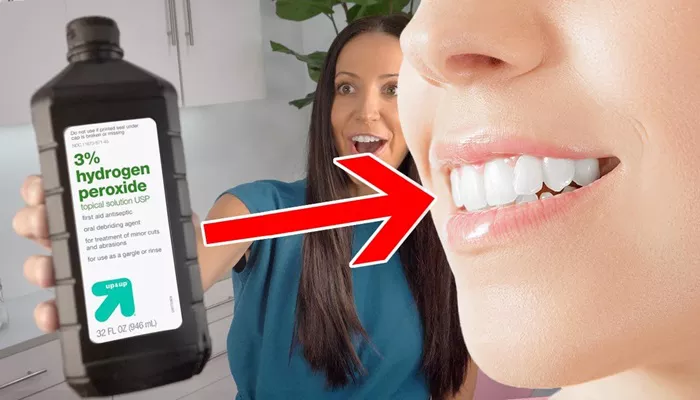Gingivitis is a common and mild form of gum disease. It causes irritation, redness, and swollen gums around the base of your teeth. It is often caused by poor oral hygiene that allows plaque to build up on the teeth. If left untreated, gingivitis can progress to more serious gum diseases, such as periodontitis, and may even result in tooth loss.
Signs and Symptoms of Gingivitis
The most common symptoms of gingivitis include:
- Bleeding gums when brushing or flossing
- Swollen gums that are red and tender
- Bad breath
- Receding gums
- Soft or puffy gum tissue
What Is Hydrogen Peroxide?
A Brief Overview
Hydrogen peroxide (H2O2) is a mild antiseptic that is commonly used to clean wounds and disinfect surfaces. In dental care, it is found in many mouthwashes and whitening products. Its bubbling action helps remove debris and dead tissue, making it a popular choice for home oral care routines.
How Does Hydrogen Peroxide Work?
Hydrogen peroxide works by releasing oxygen when it comes into contact with tissue. This action helps:
- Kill bacteria in the mouth
- Remove trapped food and debris
- Reduce plaque formation
- Minimize gum inflammation
Can Hydrogen Peroxide Cure Gingivitis?
Scientific Evidence and Research
Hydrogen peroxide has antibacterial properties that can help reduce the bacterial load in the mouth. Some clinical studies suggest that using a diluted hydrogen peroxide solution can reduce gum inflammation and bleeding. However, it is important to understand that hydrogen peroxide is not a cure-all.
While it can support the healing process, especially when combined with regular brushing, flossing, and professional cleanings, it does not replace the need for routine dental care. Gingivitis is caused by plaque and bacteria, so consistent hygiene is essential.
How It Helps Treat Gingivitis
Hydrogen peroxide can help in the following ways:
- Reducing swollen gums by lowering bacterial activity
- Improving breath by killing odor-causing bacteria
- Decreasing gum bleeding during brushing
These effects make it a supportive treatment for gingivitis but not a standalone cure.
How to Use Hydrogen Peroxide for Gum Health
Proper Concentration
Over-the-counter hydrogen peroxide usually comes in a 3% solution. For oral use, it must be diluted with water. A safe ratio is:
1 part hydrogen peroxide to 2 parts water
This makes a 1% solution suitable for rinsing the mouth.
Mouth Rinse Instructions
Follow these steps:
- Mix one tablespoon of 3% hydrogen peroxide with two tablespoons of water
- Swish in your mouth for 30–60 seconds
- Spit it out. Do not swallow
- Rinse your mouth with plain water afterward
Use this rinse no more than once a day, and only for short-term use (a few weeks).
Benefits of Using Hydrogen Peroxide for Gingivitis
Reduces Bacteria and Plaque
Hydrogen peroxide kills bacteria that contribute to plaque and tartar formation. This helps prevent bleeding gums and gum inflammation.
Whitens Teeth Gently
While treating gingivitis, hydrogen peroxide also provides a mild whitening effect. It can remove surface stains, giving your teeth a cleaner appearance.
Improves Overall Oral Hygiene
Its bubbling action helps lift food particles and debris from between teeth and along the gumline, which helps reduce the progression of gingivitis.
Potential Risks and Side Effects
Tooth Sensitivity and Irritation
Frequent use or using undiluted hydrogen peroxide may cause:
- Tooth sensitivity
- Burning sensation in the gums
- Damage to tooth enamel
- Increased gum irritation
Not Suitable for Long-Term Use
Hydrogen peroxide is effective for short-term relief but should not be used as a daily mouthwash indefinitely. Long-term use can disrupt the balance of healthy bacteria in your mouth.
Who Should Avoid It?
People with the following conditions should avoid using hydrogen peroxide without consulting a dentist:
- Severe gum disease
- Open sores or oral ulcers
- Dental restorations like crowns or veneers (as whitening effect may be uneven)
Natural Alternatives to Hydrogen Peroxide
Saltwater Rinse
A saltwater rinse is a gentle and natural way to reduce swollen gums. Mix half a teaspoon of salt in a glass of warm water and rinse for 30 seconds.
Aloe Vera Gel
Aloe vera has natural anti-inflammatory properties. Applying it directly to the gums can help soothe irritation and promote healing.
Oil Pulling with Coconut Oil
This ancient remedy involves swishing coconut oil in your mouth for 10–15 minutes. It may help reduce bacteria and plaque buildup.
When to See a Dentist
Persistent Symptoms
If you experience bleeding gums, pain, or swelling that does not improve after a week of hydrogen peroxide use, consult a dentist. These could be signs of more serious gum disease.
Professional Cleaning
Gingivitis is often resolved with a professional dental cleaning, which removes plaque and tartar below the gumline. Hydrogen peroxide should be used as a supplement to, not a replacement for, these cleanings.
Tips for Preventing Gingivitis
Brush and Floss Daily
Brush your teeth at least twice a day with fluoride toothpaste. Flossing once a day helps remove debris between teeth and along the gumline.
Use Antibacterial Mouthwash
Use a dentist-recommended mouthwash to reduce bacteria and freshen breath. Choose products with proven ingredients like chlorhexidine or cetylpyridinium chloride.
Stay Hydrated and Eat Well
Drink plenty of water and avoid sugary foods. A balanced diet supports healthy teeth and gums.
Regular Dental Checkups
Visit your dentist at least twice a year for exams and professional cleanings. Early detection is key to preventing gum disease.
Conclusion
Hydrogen peroxide can help reduce the symptoms of gingivitis, such as bleeding gums and swollen gums, by killing harmful bacteria and promoting healing. However, it is not a cure on its own. It should be used as part of a complete oral hygiene routine that includes brushing, flossing, and regular dental visits.
For those with mild gingivitis, hydrogen peroxide can offer noticeable relief when used correctly. But if symptoms persist, professional dental care is essential. Always consult a dental expert before starting any new treatment.

